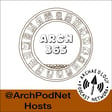Become a Creator today!Start creating today - Share your story with the world!
Start for free
00:00:00
00:00:01

Troy - Episode 18045
The world heritage site of Troy, in modern Anatolia in Turkey, best known from the homeric epics, is today known as the site of nine successive cities dating between 3000 BCE and AD 500.
Recommended
Transcript
Introduction to the Podcast
00:00:01
Speaker
You're listening to the Archaeology Podcast Network. The World Heritage Site of Troy in modern Anatolia in Turkey, best known from the Homeric epics, is today known as the site of nine successive cities dating between 3000 BCE and AD 500.
Daily Archaeology Topics in ARC 365
00:00:18
Speaker
This is episode 45 for February 14th, 2018. I'm Chris Webster, and welcome to the ARC 365 podcast, 2018 edition. ARC 365 is a podcast today, every day, in 2018.
Merchandise Partnership with Tea Public
00:00:31
Speaker
The Archaeology Podcast Network has partnered with Tea Public to bring you some awesome gear that looks good, promotes archaeology, and puts a few pennies in our pockets so you can get free podcasts. Check out our designs at arkpodnet.com slash shop. That's arkpodnet.com slash shop.
The Historicity of Troy
00:00:45
Speaker
This episode is written by Christopher Booth. Troy was a city situated in the far northwest of the region known in late classical antiquity as Asia Minor, now Anatolia in modern Turkey. The city was the setting of the Trojan War described in the Greek epic cycle, in particular in the Iliad,
00:01:00
Speaker
and epic poem attributed to Homer. With critical history becoming the theoretical basis of most historical thought in the late 19th century, the idea of the city of Troy and the Trojan War were largely considered to be legendary rather than real. However, the location of Troy had been the subject of interest since classical times, so was not easily dismissed.
00:01:19
Speaker
The first person to identify the current agreed location of Troy with the ancient city was Scottish journalist Charles McLaren in 1822. However, it wasn't until 1866 that Frank Calvert began to carry out extensive survey and minor excavations on the site. He published the results of his work and identified the hill, which was on his family's land at the time, with New Ilium, a city founded by Romer Emperor Augustus that was traditionally considered to be a successor to Troy.
Schliemann's Excavations and Discoveries
00:01:44
Speaker
Those publications drew the attention of Heinrich Schleiman,
00:01:47
Speaker
the most famous archaeologist associated with the site. He visited in 1868 and gained permission to excavate at the site. Digging between 1871 and 1873 and 1878 and 1879, he discovered the many successive cities built one atop another at the site which dated between the Bronze Age and the Roman period. Initially, Schliemann declared Troy I now dated to 3000-2600 BCE and later Troy II, now dated to 2600-2250 BCE,
00:02:14
Speaker
to be the Homeric city of Troy, an identification that was widely accepted at the time.
Post-Schliemann Discoveries at Troy
00:02:18
Speaker
Unfortunately, his excavations were condemned by later archaeologists since it appears that he irreparably damaged the layers which have now been identified with the Homeric era city, Troy VIIa.
00:02:28
Speaker
After Schliemann, William Drupfield and later Carl Blagan continued to excavate at the site, and these were the excavations that defined the nine successive cities that were built at this site. In 1988, excavations resumed under a team from the University of Tübingen and the University of Cincinnati, and these excavations were when Troy VIIa
00:02:46
Speaker
1300 to 1190 BCE was confidently associated with the Trojan War through the recovery of bronze arrowheads and fire-damaged human remains as well as outer defensive ditches dated to the same period. This is now the layer of the city that is accepted by archaeologists and historians as the city referred to in the Iliad. This has only been a brief introduction of the fascinating site of the city of Troy and there's a lot more we could have talked about from the nine layers of the city spanning three and a half thousand years of human
Exploring More Episodes and Support
00:03:13
Speaker
history. Thank you.
00:03:21
Speaker
Thanks for listening to Ark 365. If you want to hear more Ark 365, check out www.arkpodnet.com slash ark365 for the 2017 and 2018 episodes. Check out arkpodnet.com slash ark365-g30 for the last 30 episodes. Please subscribe and rate on your service of choice. We're available on iTunes, Stitcher, and Google Play among others. Support the APN at arkpodnet.com slash members. Thanks for listening and thanks for being awesome.
00:03:50
Speaker
This show is produced and recorded by the Archaeology Podcast Network, Chris Webster and Tristan Boyle, in Reno, Nevada at the Reno Collective. This has been a presentation of the Archaeology Podcast Network. Visit us on the web for show notes and other podcasts at www.archpodnet.com. Contact us at chrisatarchaeologypodcastnetwork.com.
